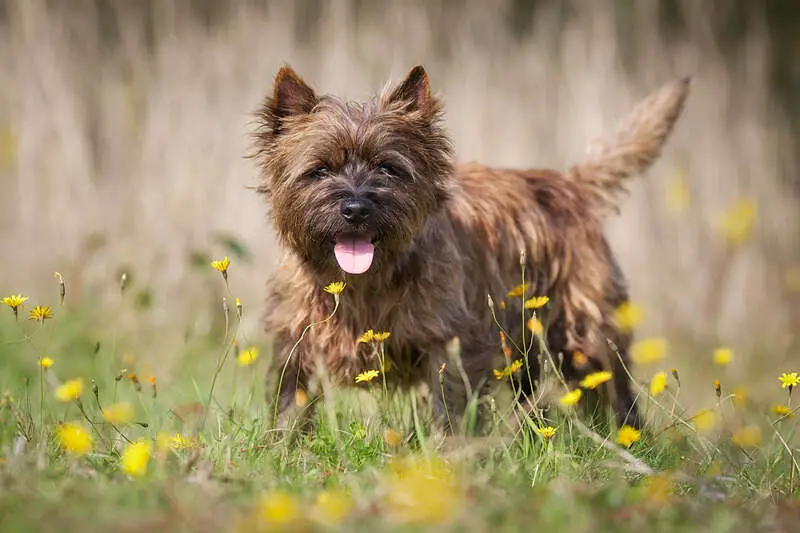The Cairn Terrier entered the realm of iconic dogs in 1939, when a female named Terry starred as “Toto” in The Wizard of Oz. These little but tough ruff-faced pooches exude personality, and they’re just as happy dwelling downtown as they are chasing rats on a sprawling farm: an ancient occupation of the breed.

The Cairn Terrier dog breed
Breed history
The Cairn Terrier emerged from that murky category of ratters and vermin-hunters cultivated in Scotland for centuries and formerly loosely lumped together as “Scotch Terriers.” The American Kennel Club notes that, while the name “Cairn Terrier” doesn’t appear in print until the end of the 19th century, this scruffy breed had been distinguished from its fellows – including what came to be known as Scottish, Skye, and West Highland White terriers – long before. An early name for the Cairn was the Short-haired Skye Terrier, and indeed the Isle of Skye is strongly associated with some of its earliest breeding.
The modern name stems from the rockpiles known as cairns that have been used since time immemorial to mark crossroads, property boundaries, and other points of interest. Cairn Terriers came of age in Scotland rooting out rodents from these cairns, and also were commonly run in groups to hunt bigger, toothier creatures such as otters and foxes. For example, Captain Martin MacLeod of the Isle of Skye, one of the well-known early breeders of the Cairn Terrier, maintained a pack of them to assist with his enthusiastic otter-hunting.
By the late 1800s and early 1900s, Cairn Terriers were well separated from their “Scotch Terrier” cousins; the American Kennel Club formally recognized the breed in 1913, a couple of decades before Dorothy’s faithful and feisty companion rocketed it to worldwide renown.
Appearance
The broad, well-furred head with its small pricked ears gives the Cairn Terrier a face commonly described as foxlike. Its strong but nimble-looking body with its short legs and heavy nails reflect all those formative generations of digging, ferreting, and chasing on the Highlands. Their lush, “weatherproof” coat – a badge of honor from the rainsocked Scottish Highlands, you might say – comes double-layered with stiff, wiry guard hairs and a downier undercoat.
Cairn Terriers come in a variety of colors, including black, brindle, wheaten, and red. Many terriers darken with age, though some yellowish or reddish dogs stay that way through life.
An average Cairn Terrier weighs perhaps 13 or 14 pounds and stands about 10 inches tall.
Personality & temperament
Smart, active, and close-bonding, the Cairn Terrier makes a wonderful companion for those willing to give it the attention and training it requires. They do well in a wide variety of living arrangements, from the rural countryside reminiscent of their homeland to big-city apartments, as long as they get enough exercise.
Cairn Terriers enjoy attention from their owners, though they’ve certainly got an independent streak. They’re a nice mix of affectionate, highly social, and self-directed. Like many a dog, they’re liable to act out if neglected and under-stimulated.
Eager and alert barkers, Cairn Terriers make excellent watchdogs; if you want a quiet pet, this isn’t the choice for you.
Cairn Terriers can make fine housemates with children, toward which they’re often notably patient and forgiving. That said, an overeager, pushy kid will eventually be reprimanded with a sharp nip from this strong-willed earthdog, which doesn’t take kindly to be being pushed around or harassed. Some experts don’t recommend mixing Cairn Terriers with very small children, unless you can keep them all under close supervision and can make allowances for individual personalities – those of the children and of the dog in question.
It shouldn’t surprise you that Cairn Terriers will leap into chase of rabbits, squirrels, cats, and other small animals outside: A leash is a must. They also love to express their bloodline through digging, so keep that in mind around the yard and the garden.
Shedding / grooming
Cairn Terriers don’t shed heavily as long as you groom them regularly: Give them a good brushing and combing once a week or so. Occasional hard-stripping – the removal of dead and loose hairs – helps maintain the coat in good condition. Keep those impressive nails clipped regularly, too.
Health & lifespan
The Cairn Terrier is a relatively long-lived purebred, with a life expectancy commonly reaching 15 years or even more. Among the health issues to watch out for are luxated patellae (a dislocated-kneecap condition widespread among many smaller dogs), cataracts, ocular melanosis, hypothyroidism, renal dysplasia, and Von Willebrand disease and other blood-clotting disorders.
Exercise needs
Give your Cairn Terrier daily exercise: a long, leashed walk if possible, and on days of dismal weather indoor ballgames and other hearty play. (Keep in mind, though, that this is a breed designed for rain and damp.) Give them free-ranging fun only in a fenced yard, and keep an eye on them to counter any sudden urges to dig up the flowerbeds or root under the fenceposts.
Training / intelligence
Dedicated, focused positive-reinforcement training is crucial for encouraging good behavior and obedience in the Cairn Terrier, an intelligent beast with plenty of mettle and a tendency to go its own way. In gentle but firm and consistent manner, let your Cairn know who’s at the top of the pecking order. Socialize puppies early and set the stage for hassle-free brushing, combing, and nail-trimming by getting them used to affectionate grooming sessions.
